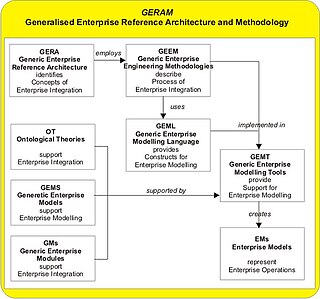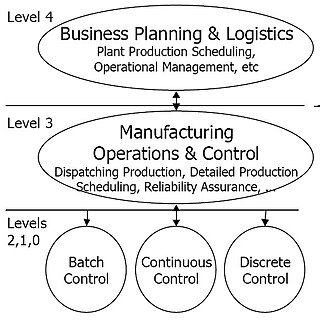
August-Wilhelm Scheer is a German Professor of business administration and business information at Saarland University, and founder and director of IDS Scheer AG, a major IT service and software company. He is known for the development of the Architecture of Integrated Information Systems (ARIS) concept.

The Zachman Framework is an enterprise ontology and is a fundamental structure for enterprise architecture which provides a formal and structured way of viewing and defining an enterprise. The ontology is a two dimensional classification schema that reflects the intersection between two historical classifications. The first are primitive interrogatives: What, How, When, Who, Where, and Why. The second is derived from the philosophical concept of reification, the transformation of an abstract idea into an instantiation. The Zachman Framework reification transformations are: identification, definition, representation, specification, configuration and instantiation.

CIMOSA, standing for "Computer Integrated Manufacturing Open System Architecture", is an enterprise modeling framework, which aims to support the enterprise integration of machines, computers and people. The framework is based on the system life cycle concept, and offers a modelling language, methodology and supporting technology to support these goals.
Enterprise architecture (EA) is a business function concerned with the structures and behaviours of a business, especially business roles and processes that create and use business data. The international definition according to the Federation of Enterprise Architecture Professional Organizations is "a well-defined practice for conducting enterprise analysis, design, planning, and implementation, using a comprehensive approach at all times, for the successful development and execution of strategy. Enterprise architecture applies architecture principles and practices to guide organizations through the business, information, process, and technology changes necessary to execute their strategies. These practices utilize the various aspects of an enterprise to identify, motivate, and achieve these changes."

Enterprise integration is a technical field of enterprise architecture, which is focused on the study of topics such as system interconnection, electronic data interchange, product data exchange and distributed computing environments.

Computer-integrated manufacturing (CIM) is the manufacturing approach of using computers to control the entire production process. This integration allows individual processes to exchange information with each part. Manufacturing can be faster and less error-prone by the integration of computers. Typically CIM relies on closed-loop control processes based on real-time input from sensors. It is also known as flexible design and manufacturing.
A federal enterprise architecture framework (FEAF) is the U.S. reference enterprise architecture of a federal government. It provides a common approach for the integration of strategic, business and technology management as part of organization design and performance improvement.

An enterprise architecture framework defines how to create and use an enterprise architecture. An architecture framework provides principles and practices for creating and using the architecture description of a system. It structures architects' thinking by dividing the architecture description into domains, layers, or views, and offers models – typically matrices and diagrams – for documenting each view. This allows for making systemic design decisions on all the components of the system and making long-term decisions around new design requirements, sustainability, and support.
A reference model—in systems, enterprise, and software engineering—is an abstract framework or domain-specific ontology consisting of an interlinked set of clearly defined concepts produced by an expert or body of experts to encourage clear communication. A reference model can represent the component parts of any consistent idea, from business functions to system components, as long as it represents a complete set. This frame of reference can then be used to communicate ideas clearly among members of the same community.

Enterprise modelling is the abstract representation, description and definition of the structure, processes, information and resources of an identifiable business, government body, or other large organization.

Dennis E. Wisnosky is an American consultant, writer and former chief architect and chief technical officer of the US DoD Business Mission Area (BMA) within the Office of Business Transformation. He is known as one of the creators and initiators of the Integrated Definition (IDEFs) language, a standard for modeling and analysis in management and business improvement efforts.

A view model or viewpoints framework in systems engineering, software engineering, and enterprise engineering is a framework which defines a coherent set of views to be used in the construction of a system architecture, software architecture, or enterprise architecture. A view is a representation of the whole system from the perspective of a related set of concerns.

Treasury Enterprise Architecture Framework (TEAF) was an enterprise architecture framework for treasury, based on the Zachman Framework. It was developed by the US Department of the Treasury and published in July 2000. May 2012 this framework has been subsumed by evolving Federal Enterprise Architecture Policy as documented in "The Common Approach to Federal Enterprise Architecture".

FDIC Enterprise Architecture Framework was the enterprise architecture framework of the United States Federal Deposit Insurance Corporation (FDIC). A lot of the current article is about the enterprise architecture framework developed around 2005, and currently anno 2011 out-of-date.

NIST Enterprise Architecture Model is a late-1980s reference model for enterprise architecture. It defines an enterprise architecture by the interrelationship between an enterprise's business, information, and technology environments.

Generalised Enterprise Reference Architecture and Methodology (GERAM) is a generalised enterprise architecture framework for enterprise integration and business process engineering. It identifies the set of components recommended for use in enterprise engineering.

James G. "Jim" Nell is an American engineer. He was the principal investigator of the Manufacturing Enterprise Integration Project at the National Institute of Standards and Technology (NIST), and is known for his work on enterprise integration.
The Singapore Government Enterprise Architecture (SGEA) programme was established to support and enable the business strategies, objectives, and a vision of a 'Networked Government'. It adopted a federated architecture approach similar to the United States government. It is a set of blueprints: the Business Architecture (BA), Information Architecture (IA), Solution Architecture (SA) and Technical Architecture (TA) of the Singapore Government. It provides a holistic view of business functions, common data standards, and shared ICT systems and infrastructure. This programme facilitates the identification of opportunities for collaboration among agencies, encouraging greater sharing of data, systems and processes across agencies.

Purdue Enterprise Reference Architecture (PERA), or the Purdue model, is a 1990s reference model for enterprise architecture, developed by Theodore J. Williams and members of the Industry-Purdue University Consortium for Computer Integrated Manufacturing.
The history of business architecture has its origins in the 1980s. In the next decades business architecture has developed into a discipline of "cross-organizational design of the business as a whole" closely related to enterprise architecture. The concept of business architecture has been proposed as a blueprint of the enterprise, as a business strategy, and also as the representation of a business design.















